College Exhibition: Royal College of Art Show 2007
Wed, 20 Jun 2007The Royal College of Art's annual post graduate degree show had a new name and a new venue this year. Held for the first time in a large pavilion tent in Kensington Gardens, directly opposite the main Royal College of Art building, 'The Great Exhibition' commemorates the 150th birthday of the South Kensington cultural and educational institutions. Car Design News caught up with a few of the 18 Vehicle Design graduates at a private viewing on June 14th.
Swiss designer Filip Krnja - who has worked at Mercedes-Benz, Volkswagen and Mitsubishi before enrolling at the RCA - displayed 'Nordauki', a fuel-cell race cart that features two wheels (mounted side by side like a Segway) with supplementary power provided by a kite. Inspired by Japanese Anime, the vehicle was designed not for this world, but for Nordauki: the heroine of a science-fiction film Krnja co-created. Reminiscent of Roman chariots, the concept was modeled in Hong Kong by a professional Manga figurine modeler. The hard model presented at the show features a girl from a desert tribe holding two steering 'reigns' and a robot charged with flying the kite.
When asked why he had chosen to create an entire story line to revolve around his project, Krnja said: "When you create a design which is integrated into a story it has its own criteria, it makes sense on its own and is in a way complete, so it's easier to communicate to a larger audience." The project and its presentation thereby crosses areas of vehicle design, character design, music, film and designer toy production all in one, conveying form language and effectively connecting with viewers.
Play video: 'Nordauki' by Filip Krnja
South Korean graduate Chan-whie Park designed 'Hammered', a retro-future single seat sports car inspired by a classic wooden buck he saw while interning at Pininfarina's studios and the traditional Italian Cariciosa process of forming aluminum bodies over these bucks. Stemming from Italian armor production, Park claims the older process of hammering can be reincorporated into new designs thanks to the advancement of current aluminum technologies. Park's design features four modular structures incorporating the suspension components and engineering structure that clip on and off of the main frame. Though the design on the model shown was asymmetrical, Park says manufacturers could also create symmetrical modules, allowing designers more creative freedom in styling the body.
Presented in full-size as the center piece of the entire RCA exhibit was Florian Seidl's 'Autopia', a helicopter for a future London described by Audous Huxley's 1932 book: Brave New World. Seidl also took inspiration form historic London-based vehicles (such as the black cab and double decker buses) to create a futuristic helicopter described vaguely by Huxley.
"In the 1930's helicopters were in their infancy and very different from what we know now, so I did some research into what kind of helicopter it should be," shared Seidl. The result is two counter rotating 5-meter diameter rotors to counter balance the vessel, allowing everything to be built on a vertical axis with the pilot riding above the two-seat passenger compartment. Made entirely of styrofoam and milled by UK based Codec following Seidl's Alias renderings, the biggest challenge was getting it in to the pavilion. "We had to take out one of the side walls of the tent and get it in horizontally" says Seidl, "The entire thing took 7 or 8 guys."
Play video: 'Autopia' by Florian Seidl
Matt Croft's 'Second Life' explored how an eco-aesthetic might be developed for application in both economy and premium cars. He chose Lada and Maserati to represent these two spectrums and used recycled plastics, molded cork, reduced part numbers and a re-used watch as elements within his two eco-aesthetics.
"I started looking at trends of people wanting to express their environmental credentials," said Croft, "And I decided to fit this with Maserati as a brand. Recycled materials will be the way we have to go eventually, so I started playing around with different materials. The felt in the Maserati has a more luxury feel." The model also features large bolts attaching the various panels to the structure. "With a recycled car, you'd want to keep the materials separate so you could separate the materials and recycle them again," explained Croft.
With the Lada concept, Croft aimed the design at young teenagers and appealed to the retro-trend. The anti-establishment brand vehicle utilizes more synthetic materials compared to the Maserati example, blending textures and colors around an iconic saloon car form. In addition to creating a modular system with shared body panels, users could incorporate some of their own bits to infinitely customize the car. "Feasibly, if a customer likes to drink 7-Up they could save the bottles and recycle them to create the rear end of their car," said Croft.
Thomas Hooper's project takes inspiration and its name from the 'Car Capers' game he played as a child and from his observation that people's appropriation of cars (and other products) often results in more interesting designs than the originals. His design is a package of 12 elements that represent the core virtual parts of a car that is constructed on-line by a broad spectrum of users disenfranchised from the normal superficial car specification process.
"I used to put the wrong combination of pieces together which resulted in something quite creative and interesting, this is what drew my attention to the fact that people perhaps want to be more creative in their input when they by a car." Hooper said. The concept is a virtually modular web-based participatory experience where buyers can put together a car from an inventory of parts. "The hope is that this can cater to many different people's functional needs and aesthetic preferences as possible," said Hooper.
Continues...
By Eric Gallina



